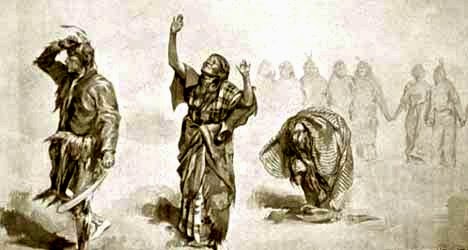Photo: legendsofamerica.com
The Northern Paiute prophet Jack Wilson, known as Wovoka, had a vision that Jesus Christ had returned as a Native American and that Christ would save Native American believers by causing the disappearance of white settlers if the Indians participated in a ritual called the Ghost Dance. This dance phenomenon alarmed the US Army, leading to the arrest of Indian leaders to prevent an Indian uprising.
Photo: legendsofamerica.com
While American authorities were arresting Indian leaders, Lakota Sioux medicine man Sitting Bull was shot and wounded, raising tensions on both sides. The members of Sitting Bull's band joined Lakota Chief Spotted Elk, also known as Big Foot, on the Cheyenne River Indian Reservation in western South Dakota. Big Foot and his people were intercepted by a detachment of the US 7th Cavalry, who escorted the band to Wounded Knee Creek on the Pine Ridge Indian Reservation, and instructed them to make camp.
Photo: aktalakota.stjo.org
The next day, December 29, 1890, soldiers attempted to disarm Big Foot's band. Tensions were high and not all the Lakota understood the orders of the soldiers. A gun went off -- no one knows whose -- and then five of the Lakota men fired their rifles at the soldiers. Allegedly, they were pushed to this by medicine man Yellow Bird who was performing the Ghost Dance.
Photo: encore-editions.com
Most of the gunfire was at close range. Women and children attempted to flee but they were targeted by soldiers with rapid fire guns while the wounded were shot and killed by other soldiers. 300 out of 350 Lakota were killed, including 44 women and 18 children. The US Army only lost 25 men. The Wounded Knee Massacre is considered the end of the Indian Wars.
Photo: geneologyreligion.net





































